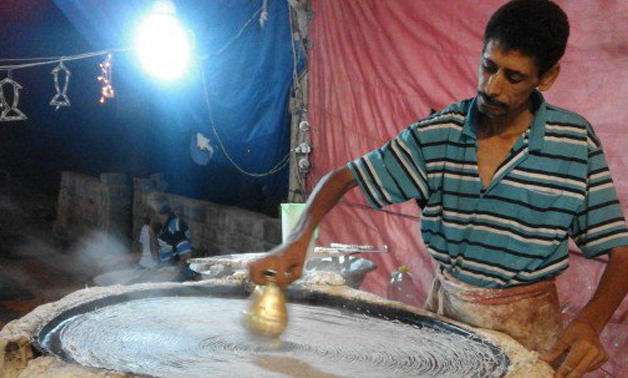
Saad Is Baking Kunafa - File photo
CAIRO - 30 May 2017: For many centuries, Muslims in the Arab world enjoy special traditional desserts during the holy month of Ramadan, in which they fast from dawn to dusk.
“Ramadan is the season of kunafa and qatayef and almost all people come here to buy them,” Mohamed Hamed, owner of a kunafa and qatayef bakery, told Egypt Today.

Hamed, owner of the Kunafa nakery talks with Egypt Today
Kunafa and qatayef pastry is made of a mixture of flour, water, and powdered milk.
Holding a cup-shaped strainer with liquefied dough, the kanafani (kunafa baker) makes string-shaped pastry on a round-shaped iron tray of the oven, while qatayef is baked in a round shapes.
“I have been a Kananfani since I was 15 years old; I learned this craft from my dad and grandfather,” said Saad Ragab Saad while pouring the dough on a tray in round shapes. Beside him, his 13-year-old son was watching to learn the craft.

Saad Ragab Saad
Saad, 41, added that he comes from Qalyubia governorate in the Delta to Helwan town in Cairo every Ramadan only to sell kunafa.
Mothers and homemakers prepare different recipes of kunafa and qatayef to be stuffed with nuts, fruits, cream, or a variety of cheese, especially for their children.
“In the first day of Ramadan, I bought 500 grams of kunafa and 500 grams of qatayef for my grandchildren,” Amouna al-Maadawy, 60-year-old housewife, told Egypt Today.
Mourad Abdel Hamid, a barber, said his daughters always ask him to buy kunafa and qatayef, adding that he bought his family these desserts more than seven times this Ramadan.
“The children are gathering here to see how the Kunafa and Qatayef are being baked,” said Hamed, who started his career as a Kanafani in 1982.
Egyptian or Levantine?
Some Islamic historians say kunafa dates back to the Fatimid Caliphate, when the Caliph Moezz Li-Dinillah entered Egypt in Ramadan and people welcomed him with this kind of dessert.
Other historians say of Kunafa and qatayef date back to the era of the Umayyad Caliphate; Levantine dessert makers prepared these desserts for Muawiyah I, the founder of the Caliphate, after he complained from hunger during fasting Ramadan.
Kunafa machines
Kunafa and qatayef became the main desserts in all Egyptian desserts shops when new machines were invented to make Kunafa in the 1990s. Since it make easier to make, kunafa became available all year long, not only in Ramadan.
“People in Ramadan prefer to eat the handmade kunafa; I sell handmade kunafa more than the machine-made one,” Hamed said.
He added that in the past, the government allocated 30 sacks of flour for each bakery nationwide during Ramadan; but now there are no governmental subsidiaries during the month


Comments
Leave a Comment